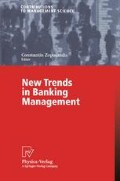Summary
This paper presents an application of automated knowledge acquisition in classification problems. The problem under examination is the classification of a sample of 130 enterprises into 5 different categories of credit risk. The data are both numerical and linguistic in nature, adding up to a total of 70 attributes. All data are obtained from an application form, which the company completes at a bank when seeking a loan and the only field which is provided by the bank is the final class. This classification task deals with statistical models, which try to give a clear view of the importance of every attribute by assigning a weight to it. Then, by multiplying each weight with the value of each corresponding attribute, the method produces a score. According to the range of the score the bank makes its decision. The problem, however, is that this method is very time consuming as it requires a long adaptation period in order to achieve the right results. The alternative solution presented in this paper is a combination of the fuzzy c-means clustering algorithm in conjunction with the Kohonen artificial neural network, which has a self-organizing Kohonen map. The basic idea behind this combination is to take advantage of the benefits offered by the two individual methods mentioned above and to compensate for each method’s short-comings. The c-means process can be integrated into the Kohonen algorithm by replacing the learning rate with membership values thus combining the fuzzy c-means algorithm with the structure and adaptive rules of the Kohonen network.
Access this chapter
Tax calculation will be finalised at checkout
Purchases are for personal use only
Preview
Unable to display preview. Download preview PDF.
References
Adriaans, P., and Zantinge, D., (1996), Data Mining, Addison-Wesley Public
Bishop, Chris, (1995), Neural networks for pattern recognition
Bose, N. K, (1996), Neural network fundamentals with graphs, algorithms, and applications
Boyes, W.J., Hoffman, D.L., and Law S.A., (1989), “An Econometric Analysis of the Bank Credit Scoring Problem”, Jour, of Econometrics, Vol. 40, pp.3–14.
Carter, C, & Catlett, J., (1987), “Assessing credit card applications using machine learning”, IEEE Expert, Vol. 2, pp. 71–79
Desai, V.S., Convay, D.G., Crook, J.N., and Overstreet, J.A., (1997), “Credit scoring models in the credit union environment using neural networks and genetic algorithms”, IMA Journal of Mathematics Applied to Business & Industry, Vol. 8, pp. 323–346
Fayyad, V.M., Piatetsky-Shapiro, G., Smyth, P., Uthurusamy, R., (1996), Advances in Knowledge Discovery and Data Mining, AAAI & MIT Press
Freeman, James A., (1991), Neural networks
Guillen, Artis, (1992), “Count Data Models for a credit scoring system”, Third Meeting on the European Series in Quantitative Economics and Econometrics on “Econometrics of Duration, Count and Transition Models”, Paris, Dec. 10–11, 1992, pp. 1–9
Herbert, Simon, (1991), “Artificial Intelligence: Where Has It Been and Where is it Going?”, IEEE Trans. Knowledge & Data Eng., Vol. 3, No. 2, pp. 128–136
Huntsberger, T.L., (1992), Parallel Self-Organizing Feature Maps for Unsupervised Pattern Recognition, IEEE Press, New York, pp.483–495
Kohonen, Teuvo, (1989), Self-organization and associative memory, Springer - Verlag, New York
Kohonen, Teuvo, (1997), Self-organizing maps, New York, Springer
Kosko, Bart, (1992), Neural networks and fuzzy systems
Langley P. & H. Simon, (1995), “Applications of Machine Learning and Rule Induction”, Communications of the ACM, 38 (11), pp.55–64
Lewis, E.M., (1992), An Intoduction to Credit Scoring” Athena Press, San Rafael, CA, USA
Lin, C. T., (1994), Neural fuzzy control systems with structure and parameter learning
Mitchell, T.M., (1997), Machine Learning, McGraw-Hill, New York
Nelke Martin, (2000), “Business Intelligence in Financial Engineering — A combined Approach to Customer Segmentation and Database Marketing”, in Proc. of CoIL-2000, European Symposium on Computational Intelligence and Learning, 22–23 June 2000, Chios, Greece, pp. 171–177
Nomikos, I., Dounias, G., Vemmos K., (1999), “Comparison of Alternative Criteria for the Evaluation of Machine Learning in the Medical Diagnosis of Stroke”, in Proc. 3rd Int. Data Analysis Symp., Aachen, Germany, pp.63–66
Quinlan, J.R., (1986), “Induction of Decision Trees”, Machine Learning, Vol. 1, pp. 81–106
Quinlan, J.R., (1993), C4.5: Programs for Machine Learning, San Mateo: Morgan Kaufmann
Souicek, Branko, (1991), Neural and intelligent systems integration, IRIS Group, 1991
Steenackers, A. and Goovaerts M.J., (1994), “A Credit Scoring Model for Personal Loans”, Insurance: Mathematics and Economics, Vol. 8, pp. 31–34
Thomas, L.C., (1998), “Methodologies for classifying applicants for credit”, in Hand, D.J., & Jacka, S.D. (Eds.), Statistics in Finance, Arnold, UK, pp.83–103
Thomas, L.C., (2000), “A survey of credit and behavioural scoring: forecasting financial risk of lending to consumers”, International Journal of Forecasting, Vol. 16, pp. 149–172
Tsoukalas, Lefteris H., (1996), Fuzzy and neural approaches in engineering
Von Altrock, Constantin, (1997), Fuzzy logic and neuro-fuzzy applications in business and finance
Von Altrock, Constantin, (1995), Fuzzy logic and neuro-fuzzy applications explained
Vonk, E., (1997), Automatic generation of neural network architecture using evolutionary computation
Weiss, S.M., N. Indurkhya, (1998), Predictive Data Mining: A Practical Guide, Morgan Kaufmann
Zadeh, L. A., (1988), Fuzzy logic, Computer, Vol.21, No.4
Zadeh, L. A., (1965), Fuzzy Sets, Information & Control, Vol.8
Zimmerman, H. J., (1996), Fuzzy Set Theory and its Applications, Kluwer Academic Publishers Boston/Dordrecht/London
Author information
Authors and Affiliations
Editor information
Editors and Affiliations
Rights and permissions
Copyright information
© 2002 Springer-Verlag Berlin Heidelberg
About this paper
Cite this paper
Michalopoulos, M., Dounias, G., Hatas, D., Zopounidis, C. (2002). On the Use of a Combination Approach to Automated Knowledge Acquisition Based on Neural Networks and Fuzzy Logic with Regard to Credit Scoring Problems. In: Zopounidis, C. (eds) New Trends in Banking Management. Contributions to Management Science. Physica, Heidelberg. https://doi.org/10.1007/978-3-642-57478-8_6
Download citation
DOI: https://doi.org/10.1007/978-3-642-57478-8_6
Publisher Name: Physica, Heidelberg
Print ISBN: 978-3-7908-1488-0
Online ISBN: 978-3-642-57478-8
eBook Packages: Springer Book Archive

